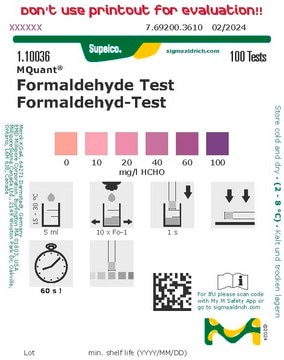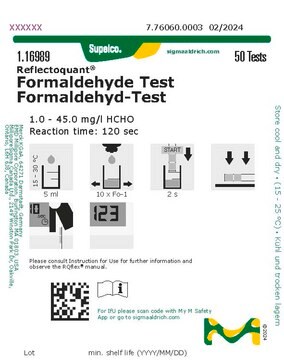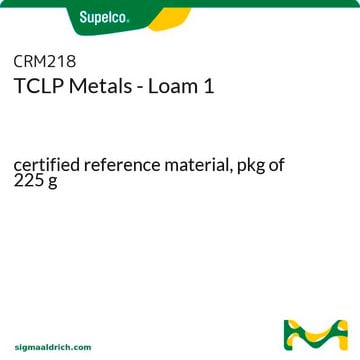The principle of this kit is the reaction of formaldehyde with acetoacetanilide in the presence of ammonia. Neither a MESNA (4-Morpholineethanesulfonic acid, sodium) buffer nor EDTA in the test sample would be expected to interfere with this reaction. Having said that, it would be appropriate to run a blank containing MESNA and EDTA, and standards spiked with MESNA and EDTA, to confirm they they are not interfering with the test result...that is, making it either artificially high or low.
Kluczowe dokumenty
MAK131
Formaldehyde Assay
sufficient for 100 fluorometric tests
Wybierz wielkość
1840,00 zł
Wybierz wielkość
About This Item
1840,00 zł
Polecane produkty
zastosowanie
sufficient for 100 fluorometric tests
metoda wykrywania
fluorometric
powiązane choroby
cancer
temp. przechowywania
2-8°C
Powiązane kategorie
Opis ogólny
Zastosowanie
- Zmodyfikowana guma naturalna jako prosty czujnik chemiczny z detekcją za pomocą smartfona do pomiaru zawartości formaldehydu w próbce owoców morza...: W tym artykule zbadano wykorzystanie zmodyfikowanej gumy naturalnej jako czujnika chemicznego w połączeniu z wykrywaniem za pomocą smartfona do pomiaru zawartości formaldehydu w owocach morza. Podejście to podkreśla potencjał dostępnych i mobilnych systemów wykrywania w zastosowaniach związanych z bezpieczeństwem żywności (Yeerum et al., 2022).
- Optyczny enzymatyczny biosensor formaldehydu oparty na oksydazie alkoholowej i wrażliwej na pH metakrylowo-akrylowej membranie optody..: W badaniu opracowano optyczny enzymatyczny biosensor formaldehydu, wykorzystujący oksydazę alkoholową z membraną wrażliwą na pH, oferujący nowatorskie podejście do szybkiego i czułego wykrywania w różnych zastosowaniach analitycznych (Nurlely i in., 2022).
Cechy i korzyści
Przydatność
Zasada
Hasło ostrzegawcze
Danger
Zwroty wskazujące rodzaj zagrożenia
Zwroty wskazujące środki ostrożności
Klasyfikacja zagrożeń
Acute Tox. 4 Oral - Aquatic Chronic 2 - Eye Dam. 1 - Met. Corr. 1 - Skin Corr. 1A - STOT SE 1 - STOT SE 3
Organy docelowe
Eyes,Central nervous system, Respiratory system
Kod klasy składowania
6.1C - Combustible acute toxic Cat.3 / toxic compounds or compounds which causing chronic effects
Wybierz jedną z najnowszych wersji:
Certyfikaty analizy (CoA)
Nie widzisz odpowiedniej wersji?
Jeśli potrzebujesz konkretnej wersji, możesz wyszukać konkretny certyfikat według numeru partii lub serii.
Masz już ten produkt?
Dokumenty związane z niedawno zakupionymi produktami zostały zamieszczone w Bibliotece dokumentów.
Klienci oglądali również te produkty
-
Is the assay compatible with MES buffer? Is EDTA affecting the reaction?
1 answer-
Helpful?
-
-
What is the limit of detection that the MAK131 Formaldehyde Assay is capable of?
1 answer-
The kit is capable of detecting formaldehyde down to 1.5 micromolar or 45 ppb. The upper end of detection for undiluted samples is 100 micromolar, which is the highest concentration of the standard curve.
Helpful?
-
Active Filters
Nasz zespół naukowców ma doświadczenie we wszystkich obszarach badań, w tym w naukach przyrodniczych, materiałoznawstwie, syntezie chemicznej, chromatografii, analityce i wielu innych dziedzinach.
Skontaktuj się z zespołem ds. pomocy technicznej












